Abstract
The method given earlier for predicting the thermodynamics of protein unfolding from the x-ray structure of a protein is applied here to the poly(L-alanine) helix. First, the fitting parameters derived earlier from a data base of 10 proteins were used to predict the unfolding thermodynamics of 4 other proteins. The agreement between the observed and predicted values is comparable to that found for the 10 proteins studied initially. Next, the temperature dependences of the Gibbs energy and enthalpy changes for unfolding of bacteriophage T4 lysozyme were predicted and compared with data in the literature. The predicted and observed temperature dependences are similar and the predicted results indicate that cold denaturation should be observed at low temperatures, as observed recently for a T4 lysozyme mutant. The fitting parameters derived from thermodynamic data for protein unfolding and for hydration of model compounds were used to predict the unfolding thermodynamics of the poly(L-alanine) helix. The results predict that helix formation is enthalpy-driven, and the predicted enthalpy change for unfolding (0.86 kcal per mol per residue) is close to the value found in a recent calorimetric study of a 50-residue alanine-rich helix.
Full text
PDF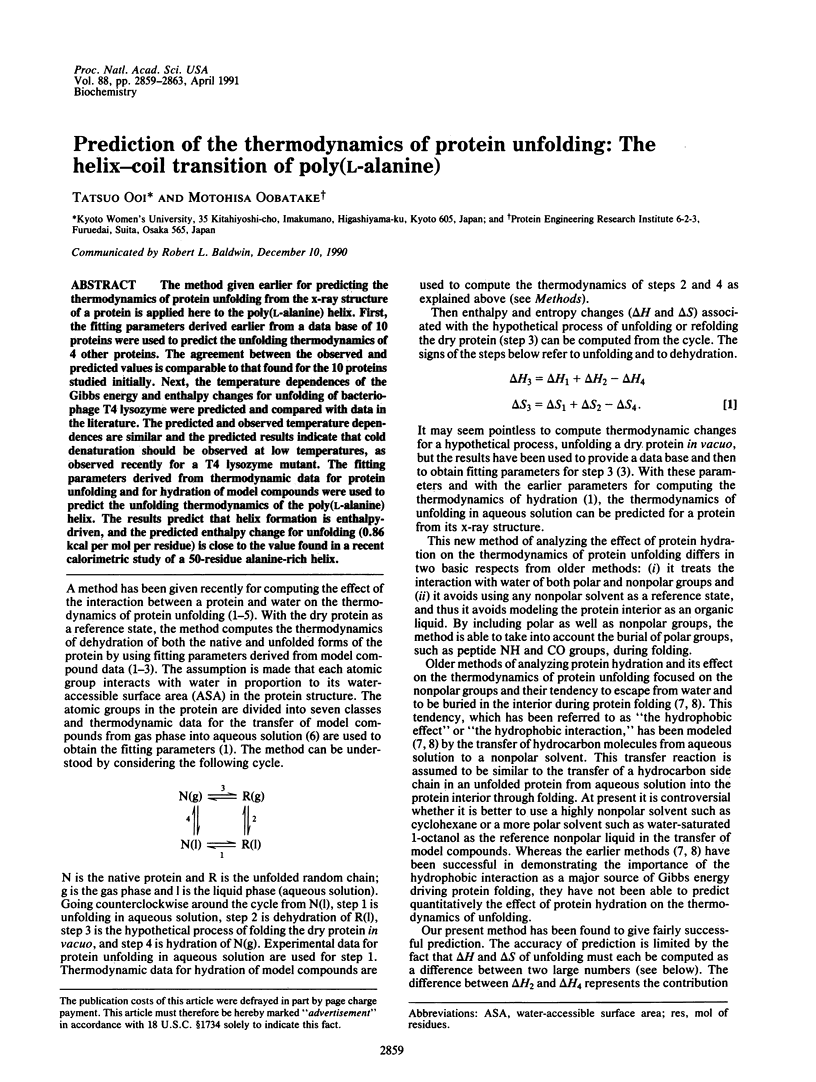
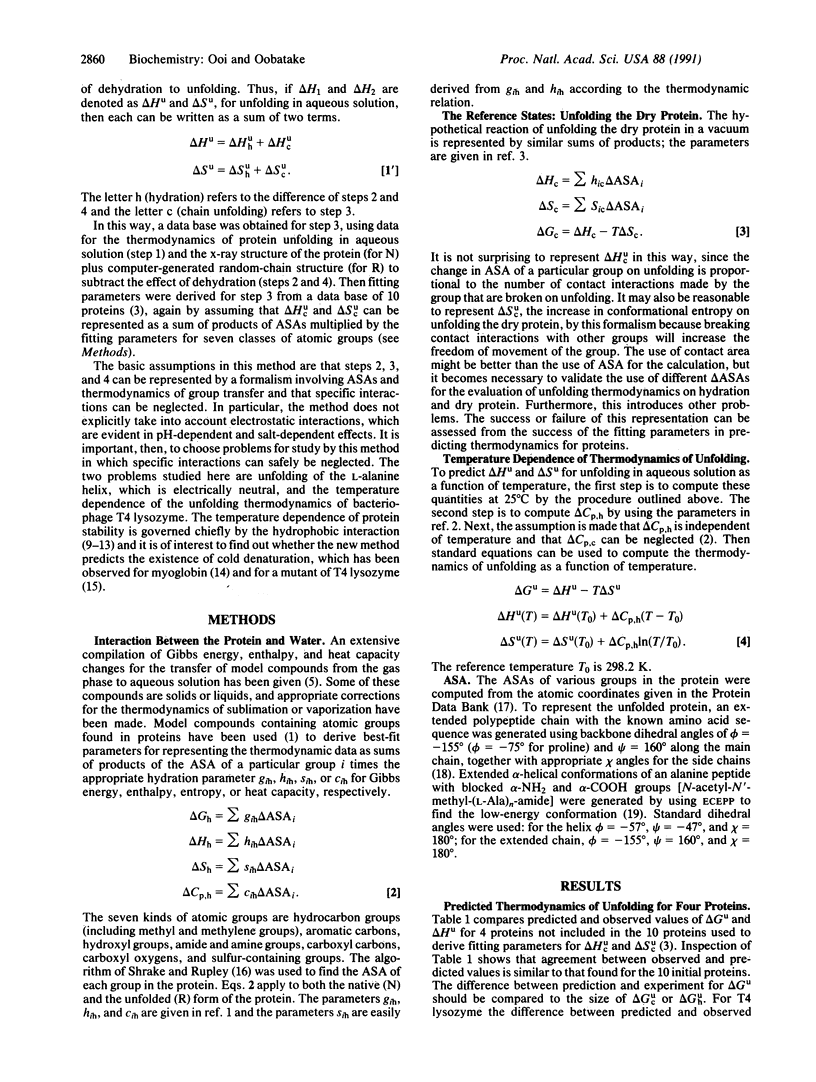
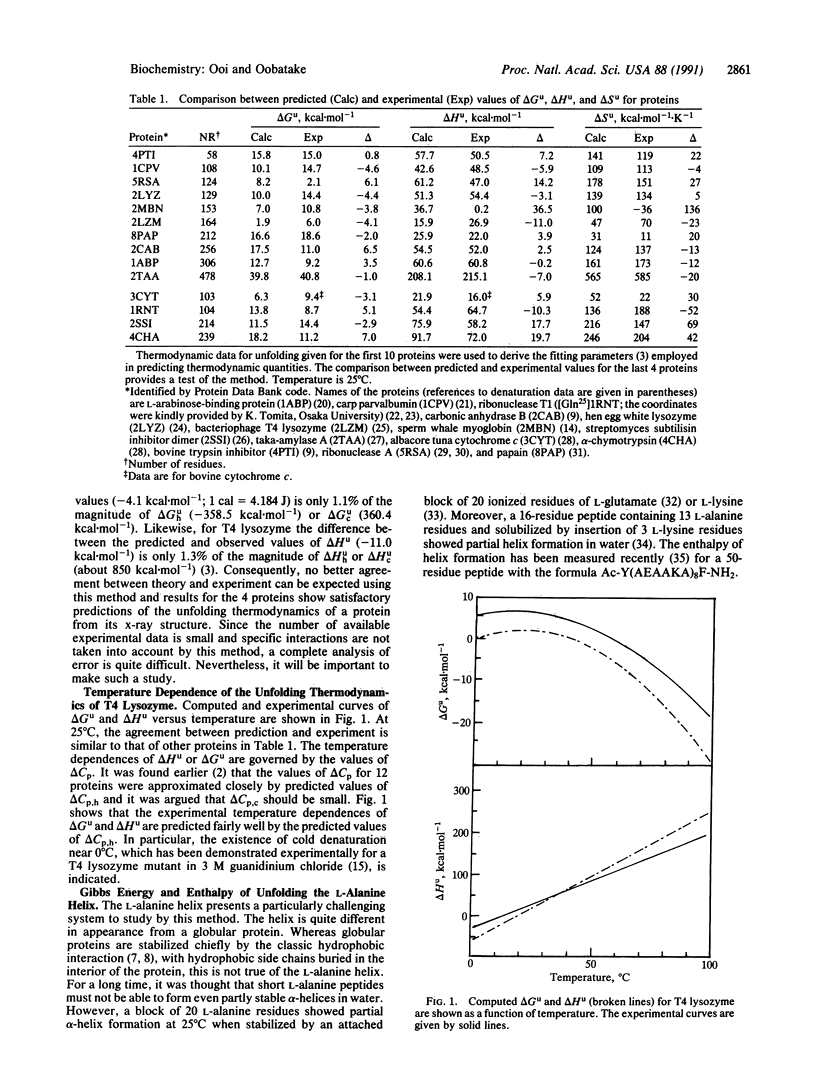
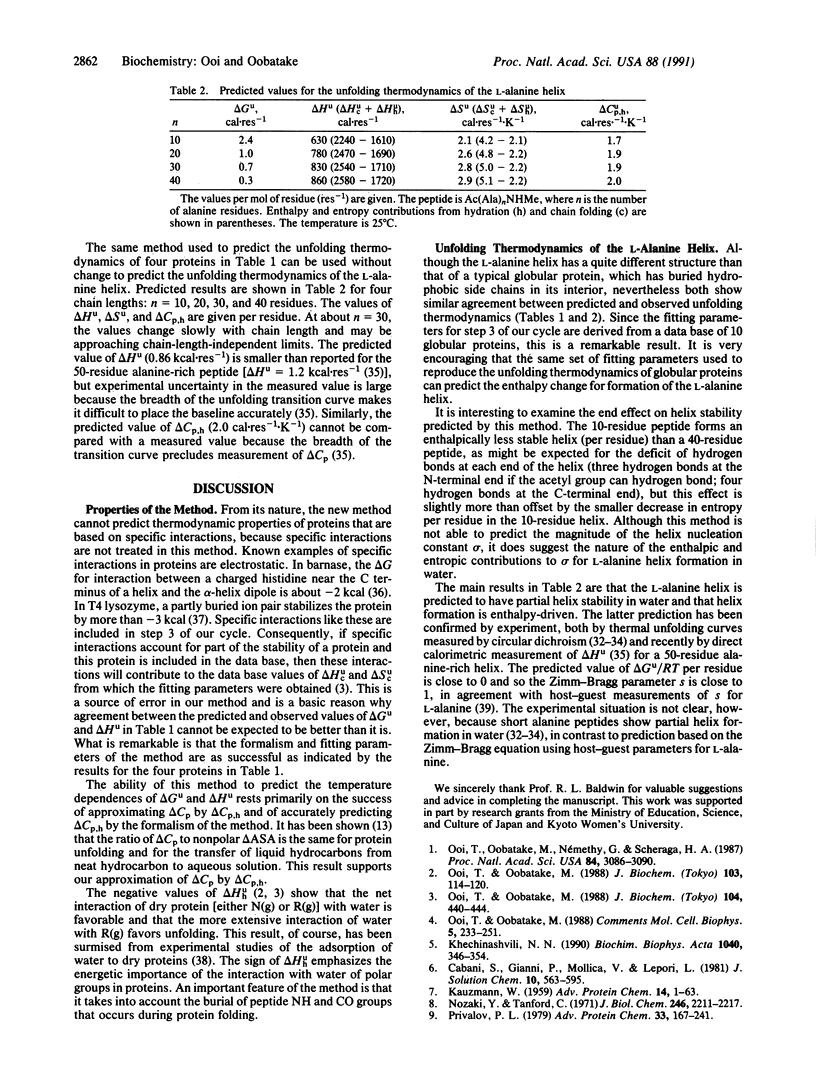
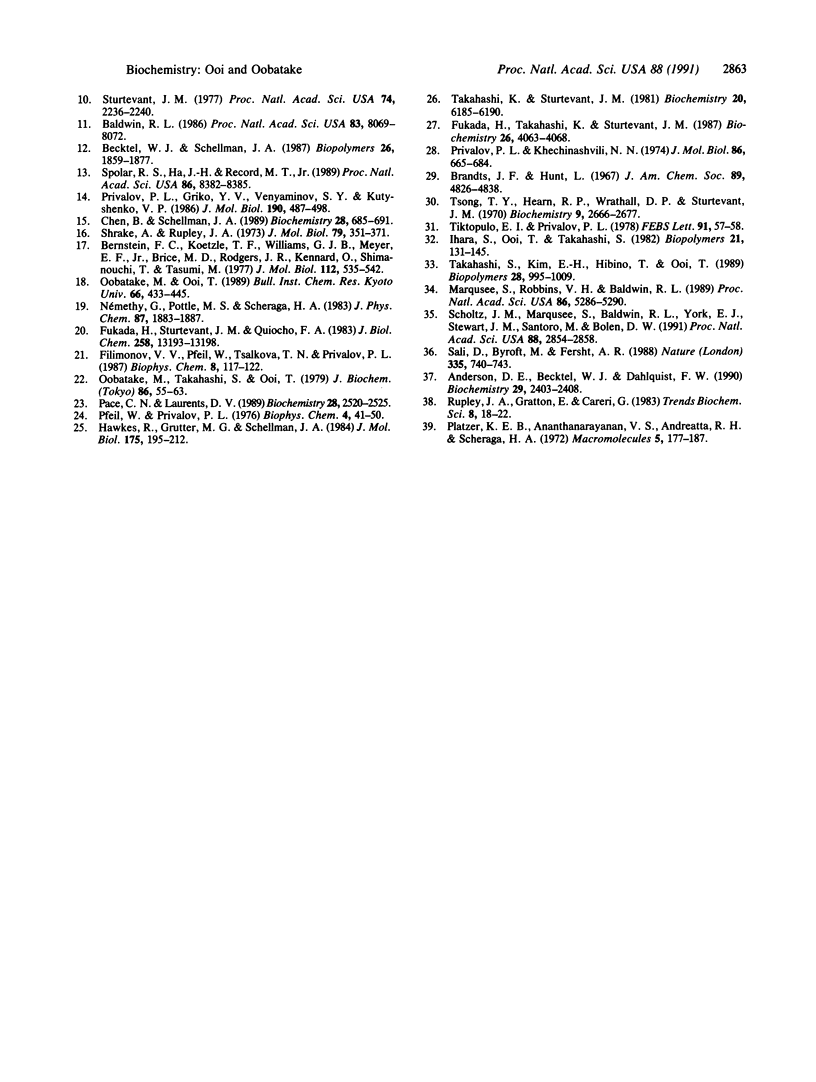
Selected References
These references are in PubMed. This may not be the complete list of references from this article.
- Anderson D. E., Becktel W. J., Dahlquist F. W. pH-induced denaturation of proteins: a single salt bridge contributes 3-5 kcal/mol to the free energy of folding of T4 lysozyme. Biochemistry. 1990 Mar 6;29(9):2403–2408. doi: 10.1021/bi00461a025. [DOI] [PubMed] [Google Scholar]
- Baldwin R. L. Temperature dependence of the hydrophobic interaction in protein folding. Proc Natl Acad Sci U S A. 1986 Nov;83(21):8069–8072. doi: 10.1073/pnas.83.21.8069. [DOI] [PMC free article] [PubMed] [Google Scholar]
- Becktel W. J., Schellman J. A. Protein stability curves. Biopolymers. 1987 Nov;26(11):1859–1877. doi: 10.1002/bip.360261104. [DOI] [PubMed] [Google Scholar]
- Bernstein F. C., Koetzle T. F., Williams G. J., Meyer E. F., Jr, Brice M. D., Rodgers J. R., Kennard O., Shimanouchi T., Tasumi M. The Protein Data Bank: a computer-based archival file for macromolecular structures. J Mol Biol. 1977 May 25;112(3):535–542. doi: 10.1016/s0022-2836(77)80200-3. [DOI] [PubMed] [Google Scholar]
- Brandts J. F., Hunt L. The thermodynamics of protein denaturation. 3. The denaturation of ribonuclease in water and in aqueous urea and aqueous ethanol mixtures. J Am Chem Soc. 1967 Sep 13;89(19):4826–4838. doi: 10.1021/ja00995a002. [DOI] [PubMed] [Google Scholar]
- Chen B. L., Schellman J. A. Low-temperature unfolding of a mutant of phage T4 lysozyme. 1. Equilibrium studies. Biochemistry. 1989 Jan 24;28(2):685–691. doi: 10.1021/bi00428a041. [DOI] [PubMed] [Google Scholar]
- Filimonov V. V., Pfeil W., Tsalkova T. N., Privalov P. L. Thermodynamic investigations of proteins. IV. Calcium binding protein parvalbumin. Biophys Chem. 1978 May;8(2):117–122. doi: 10.1016/0301-4622(78)80003-9. [DOI] [PubMed] [Google Scholar]
- Fukada H., Sturtevant J. M., Quiocho F. A. Thermodynamics of the binding of L-arabinose and of D-galactose to the L-arabinose-binding protein of Escherichia coli. J Biol Chem. 1983 Nov 10;258(21):13193–13198. [PubMed] [Google Scholar]
- Fukada H., Takahashi K., Sturtevant J. M. Differential scanning calorimetric study of the thermal unfolding of Taka-amylase A from Aspergillus oryzae. Biochemistry. 1987 Jun 30;26(13):4063–4068. doi: 10.1021/bi00387a048. [DOI] [PubMed] [Google Scholar]
- Hawkes R., Grutter M. G., Schellman J. Thermodynamic stability and point mutations of bacteriophage T4 lysozyme. J Mol Biol. 1984 May 15;175(2):195–212. doi: 10.1016/0022-2836(84)90474-1. [DOI] [PubMed] [Google Scholar]
- KAUZMANN W. Some factors in the interpretation of protein denaturation. Adv Protein Chem. 1959;14:1–63. doi: 10.1016/s0065-3233(08)60608-7. [DOI] [PubMed] [Google Scholar]
- Khechinashvili N. N. Thermodynamic properties of globular proteins and the principle of stabilization of their native structure. Biochim Biophys Acta. 1990 Sep 27;1040(3):346–354. doi: 10.1016/0167-4838(90)90132-y. [DOI] [PubMed] [Google Scholar]
- Marqusee S., Robbins V. H., Baldwin R. L. Unusually stable helix formation in short alanine-based peptides. Proc Natl Acad Sci U S A. 1989 Jul;86(14):5286–5290. doi: 10.1073/pnas.86.14.5286. [DOI] [PMC free article] [PubMed] [Google Scholar]
- Nozaki Y., Tanford C. The solubility of amino acids and two glycine peptides in aqueous ethanol and dioxane solutions. Establishment of a hydrophobicity scale. J Biol Chem. 1971 Apr 10;246(7):2211–2217. [PubMed] [Google Scholar]
- Oobatake M., Takahashi S., Ooi T. Conformational stability of ribonuclease T1. I. Thermal denaturation and effects of salts. J Biochem. 1979 Jul;86(1):55–63. [PubMed] [Google Scholar]
- Ooi T., Oobatake M. Effects of hydrated water on protein unfolding. J Biochem. 1988 Jan;103(1):114–120. doi: 10.1093/oxfordjournals.jbchem.a122215. [DOI] [PubMed] [Google Scholar]
- Ooi T., Oobatake M. Intermolecular interactions between protein and other molecules including hydration effects. J Biochem. 1988 Sep;104(3):440–444. doi: 10.1093/oxfordjournals.jbchem.a122486. [DOI] [PubMed] [Google Scholar]
- Ooi T., Oobatake M., Némethy G., Scheraga H. A. Accessible surface areas as a measure of the thermodynamic parameters of hydration of peptides. Proc Natl Acad Sci U S A. 1987 May;84(10):3086–3090. doi: 10.1073/pnas.84.10.3086. [DOI] [PMC free article] [PubMed] [Google Scholar]
- Pace C. N., Laurents D. V. A new method for determining the heat capacity change for protein folding. Biochemistry. 1989 Mar 21;28(6):2520–2525. doi: 10.1021/bi00432a026. [DOI] [PubMed] [Google Scholar]
- Pfeil W., Privalov P. L. Thermodynamic investigations of proteins. III. Thermodynamic description of lysozyme. Biophys Chem. 1976 Jan;4(1):41–50. doi: 10.1016/0301-4622(76)80005-1. [DOI] [PubMed] [Google Scholar]
- Privalov P. L., Griko YuV, Venyaminov SYu, Kutyshenko V. P. Cold denaturation of myoglobin. J Mol Biol. 1986 Aug 5;190(3):487–498. doi: 10.1016/0022-2836(86)90017-3. [DOI] [PubMed] [Google Scholar]
- Privalov P. L., Khechinashvili N. N. A thermodynamic approach to the problem of stabilization of globular protein structure: a calorimetric study. J Mol Biol. 1974 Jul 5;86(3):665–684. doi: 10.1016/0022-2836(74)90188-0. [DOI] [PubMed] [Google Scholar]
- Privalov P. L. Stability of proteins: small globular proteins. Adv Protein Chem. 1979;33:167–241. doi: 10.1016/s0065-3233(08)60460-x. [DOI] [PubMed] [Google Scholar]
- Sali D., Bycroft M., Fersht A. R. Stabilization of protein structure by interaction of alpha-helix dipole with a charged side chain. Nature. 1988 Oct 20;335(6192):740–743. doi: 10.1038/335740a0. [DOI] [PubMed] [Google Scholar]
- Scholtz J. M., Marqusee S., Baldwin R. L., York E. J., Stewart J. M., Santoro M., Bolen D. W. Calorimetric determination of the enthalpy change for the alpha-helix to coil transition of an alanine peptide in water. Proc Natl Acad Sci U S A. 1991 Apr 1;88(7):2854–2858. doi: 10.1073/pnas.88.7.2854. [DOI] [PMC free article] [PubMed] [Google Scholar]
- Shrake A., Rupley J. A. Environment and exposure to solvent of protein atoms. Lysozyme and insulin. J Mol Biol. 1973 Sep 15;79(2):351–371. doi: 10.1016/0022-2836(73)90011-9. [DOI] [PubMed] [Google Scholar]
- Spolar R. S., Ha J. H., Record M. T., Jr Hydrophobic effect in protein folding and other noncovalent processes involving proteins. Proc Natl Acad Sci U S A. 1989 Nov;86(21):8382–8385. doi: 10.1073/pnas.86.21.8382. [DOI] [PMC free article] [PubMed] [Google Scholar]
- Sturtevant J. M. Heat capacity and entropy changes in processes involving proteins. Proc Natl Acad Sci U S A. 1977 Jun;74(6):2236–2240. doi: 10.1073/pnas.74.6.2236. [DOI] [PMC free article] [PubMed] [Google Scholar]
- Takahashi K., Sturtevant J. M. Thermal denaturation of streptomyces subtilisin inhibitor, subtilisin BPN', and the inhibitor-subtilisin complex. Biochemistry. 1981 Oct 13;20(21):6185–6190. doi: 10.1021/bi00524a042. [DOI] [PubMed] [Google Scholar]
- Takahashi S., Kim E. H., Hibino T., Ooi T. Comparison of alpha-helix stability in peptides having a negatively or positively charged residue block attached either to the N- or C-terminus of an alpha-helix: the electrostatic contribution and anisotropic stability of the alpha-helix. Biopolymers. 1989 May;28(5):995–1009. doi: 10.1002/bip.360280507. [DOI] [PubMed] [Google Scholar]
- Tiktopulo E. I., Privalov P. L. Papain denaturation is not a two-state transition. FEBS Lett. 1978 Jul 1;91(1):57–58. doi: 10.1016/0014-5793(78)80016-7. [DOI] [PubMed] [Google Scholar]
- Tsong T. Y., Hearn R. P., Wrathall D. P., Sturtevant J. M. A calorimetric study of thermally induced conformational transitions of ribonuclease A and certain of its derivatives. Biochemistry. 1970 Jun 23;9(13):2666–2677. doi: 10.1021/bi00815a015. [DOI] [PubMed] [Google Scholar]


